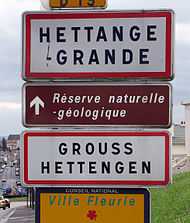Lorraine Franconian



Lorraine Franconian (Lorraine Franconian: Plàtt, lottrìnger Plàtt; French: francique lorrain, platt lorrain; German: Lothringisch) is a designation, in practice ambiguous, for dialects of West Central German (German: Westmitteldeutsch), a group of High German dialects spoken in the Moselle département in the north-eastern French region of Lorraine (See Linguistic boundary of Moselle).
The term Lorraine Franconian has multiple denotations. Some scholars use it to refer to the entire group of West Central German dialects spoken in the French Lorraine region. Others use it more narrowly to refer to the Moselle Franconian dialect spoken in the valley of the river Nied (in Pays de Nied, whose largest town is Boulay-Moselle), to distinguish it from the other two Franconian dialects spoken in Lorraine, Luxembourgish to the west and Rhine Franconian to the east.
In part due to the ambiguity of the term, estimations of the number of speakers of Lorraine Franconian in France vary widely, ranging from 30,000[1] to 400,000 (which would make it the 3rd most-spoken regional language in France, after Occitan and Alsatian).
The most reliable data come from the Enquête famille carried out by INSEE (360,000 in the 1962 census) as part of the 1999 census, but they give a somewhat indirect picture of the current situation (see Languages in France for a discussion of this survey). Approximately 78,000 people were reported to speak Lorraine Franconian, but fewer than 50,000 passed basic knowledge of the language on to their children. Another statistic illustrating the same point: Of all adult men who used Franconian regularly at age 5, less than 30% use (or used) the language regularly with their own children.[2]
Bilingual signs
References
Sources
- Auburtin, Éric. 2002. "Langues régionales et relations transfrontalières dans l’espace Saar-Lor-Lux". Hérodote 105, pp. 102—122.
- Héran, François, et al. 2002. "La dynamique des langues en France au fil du XXe siècle". Population et sociétés 376. Paris: Institut National d'Études Démographiques (INED).
- Hughes, Stephanie. 2005. Bilingualism in North-East France with specific reference to Rhenish Franconian spoken by Moselle Cross-border (or frontier) workers. In Preisler, Bent, et al., eds. The Consequences of Mobility: Linguistic and Sociocultural Contact Zones. Roskilde, Denmark: Roskilde Universitetscenter: Institut for Sprog og Kultur. ISBN 87-7349-651-0.
- Kieffer, Jean-Louis. 2006. Le Platt Lorrain de poche. Assimil. ISBN 2-7005-0374-0
External links
- Redde-n-ìhr Plàtt ? — Historical, literary, and linguistic information (in French)
- Gau un Griis — Association for the defense and promotion of Lorraine Franconian
- Plattweb
As of 10 March, 2014, _none_ of the three links above are functioning.

